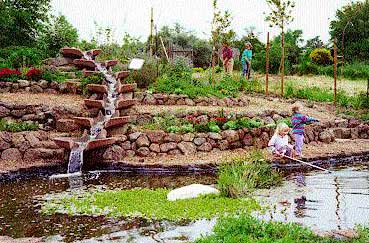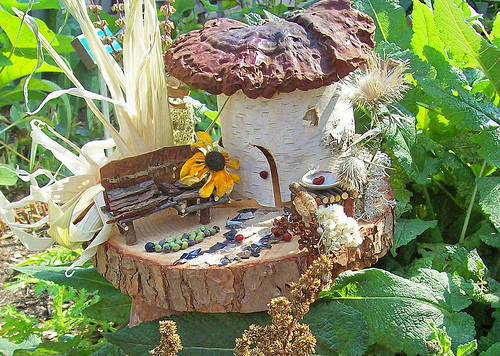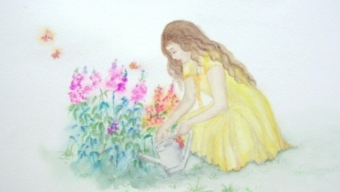I have always kept my eye out for anything that may look like a little fairy house at craft stores, yard sales, etc…
Not too long ago, Michael’s was having a sale and my husband had the afternoon off, so I got to go alone. In their floral section I found little “nests” and birdhouses, which didn’t really look like functioning bird houses, but were made of wood and covered with moss, etc..
I purchased several items and kept the bag hidden in the car until they went to their grandmother’s and I again had some free time. I carefully placed all of the items I had found all over the backyard, into hiding places within the bushes, on branches, etc…
Some they discovered right away, some are still awaiting discovery. It was interesting to watch from my window and see
how they reacted when they suddenly made a discovery – precious!
It was also interesting to see what had happened to the ones who sat in the elements for weeks – how they became a part of the landscape and truly came to look like fairies had moved into them! It was an idea which has brought many hours of joy to my children…

A flow form in the Biodynamic gardens at Rudolf Steiner College
All back yards have the potential for great discovery and activities. You should try to keep the area as natural as possible, and yet have a variety of “tools” on hand. These would include any of the following: a place for digging, a vegetable or flower garden, some wild growing plants (vines, wildflowers) wind chimes, windsocks, wind wands, pinwheels, prisms to catch the sun, gazing balls, a bonfire pit (obviously with supervision), planting sunflower houses or bean tents so children can experiment with light and dark, a water table, watering cans, seeds, potting soil and pots, scraps of wood (no nails!) for building, a long log for a balance beam, a hammock or comfortable chair, tree stumps which could be used for chairs & tables, cotton gauze cloths which could dirty, clothes pins or play clips, ropes, etc…
Simple Garden Magic:
Additionally, keeping a garden is a large part of the Waldorf curriculum. Even if you have an apartment in the city – try to keep a window box of herbs for your children. they will love it. It’s also fun to take a drive out to local farms and farmer’s markets. Steiner said:
“Although it may seem absurd, it must be stated that a person who has not learned to distinguish an ear or rye from an ear of wheat is no complete human being. It can even be said that a person who has learned to distinguish between rye and without having observed them growing in the fields, has not attained the ideal. As teachers we should avoid going on botanical expeditions to collect specimens to be shown in the classroom. The children themselves should be taken out and wherever possible, be brought to understand the plant world in its actual connection with the earth, with the rays of the sun, with life itself. Through this we can find the transition in a quite naive way to something else which is very important.” ~ Rudolf Steiner

Photo credit, Roxie Zwicker, Spirited Woodland Designs.
Biodynamic Seeds!
Biodynamic Seeds for the Home Garden: A Collection of Seeds for Fourteen Vegetables and Flowers All Raised in Biodynamic Gardens Worldwide. click here
Articles & Webs:
Kytka’s Complete List of Biodynamic Gardening Books
- Circle Garden – Lovely article by Anna Rando (.pdf file)
- Feeding the Child’s Soul in Nature (.pdf file)
- The Farmer’s Almanac
- Herb Quarterly
Recommended Reading:
- Roots, Shoots, Buckets & Boots: Gardening Together with Children Green thumbs and non-green thumbs alike will fall in love with Roots, Shoots, Buckets, & Boots, a remarkably fun and informative introduction to the wonderful world of gardening–and more specifically, gardening with children. Learn how to make everything from a pizza garden (pizza-pie-shaped, with herbs and vegetables for a fabulous pizza at harvest time), to a sunflower house (a secret hideaway with stately sunflowers and lovely creeping morning glories), to a moon garden (“Fragrance is the color of night”). Chock full of helpful hints, clever and artistic touches, and intriguing “recipes” (Moth Broth and Compost Sandwich, to name a few), this idea book will spark creativity and a lifelong fascination with gardening. Nine concepts for theme gardens are presented in a clearly defined yet non-rigid manner that is just right for encouraging young gardeners. Sharon Lovejoy, award-winning author and illustrator of several gardening books, including Hollyhock Days: Garden Adventures for the Young at Heart, has a true knack for working with all kinds of living things, including children. She understands how quickly young people will be turned off by inflexible rules, and instead encourages budding green thumbs to experiment and explore, while providing them with useful guidelines and helpful information. Wonderfully earthy watercolors make this cozy book even more welcoming.
- Developing Biodynamic Agriculture: Reflections on Early Research: Biodynamic agriculture was launched at a conference held on the Koberwitz estate in Germany. Adalbert Count Keyserlingk, the son of the hosts, was present, and this book reflects his life-long absorption in biodynamics. It presents a wide range of material, including the Count’s personal experiences of Rudolf Steiner at work, his reflection on practical research and experimentation (including photographic documentation) and descriptions of biodynamic preparations. More than anything else, however, his words successfully convey the enthusiasm, the exalted feelings and the power of initiative that arose from Rudolf Steiner’s work in this field: to found a method of farming which can provide nutritious and safe food for the future of humanity.
- Hollyhock Days: Garden Adventures for the Young at Heart: This book starts at planning a simple garden for children and adults and closes with a friendly conversation about garden critters. Each section mingles garden memories from children to grandparents, and includes poems, delicate illustrations, lists of plants, and ideas in a gentle and nostalgic way. This book inspires me to plan garden time even after a hard day or a sleepy early morning rising. My family members have always loved beautiful gardens for good, healthy eating, quiet work, or simply to gain pleasure in sweet smells and bright blooms. This book celebrates not only the garden for it’s generous gifts to people, but also the family who loves quiet and gentle times.
- Sunflower Houses: Inspiration from the Garden for Children and Their Grown Ups: As I thumb through this 10th reprint of Sunflower Houses, I am reminded of the magic right outside our doors. In the author’s words, “May you always remember that the most joyous and important experiences in life are not to be bought, but grown and nurtured in our homes and gardens.” Winter, spring, summer or fall, the outdoors hold grand adventures for us!
- Gardening for Health & Nutrition: An Introduction to the Method of Biodynamic Gardening: Long out of print, this classic introduction to biodynamic gardening introduces the gardener to an obvious, often forgotten principle: gardening is about living things, life forces, and life as such. In his introduction, John Philbrick talks of how each morning he was in the habit of meditating and communing in his garden at sunrise, until he gradually realized that the important things at work were “the forces of life”—”life is the key to existence on this planet.” He also realized that most gardeners were more concerned with death, with getting rid of things —bugs, weeds, fungi —than with life. Biodynamics is based on the interrelatedness, or the dynamics, of life forces. As Philbrick says: When you become aware of biodynamics, you become aware that everything that is alive is dependent upon everything else that’s alive, and it’s all a marvelous network of living things which are constantly changing. This book provides a simple and practical guide for the beginning gardener. It deals with planning a vegetable garden: how, when, and where to plant seeds and tools and compost making raised beds crop rotation, mulching, and companion plants harvesting, cooking, and preserving There are also sections on flowers, lawns, and home orchards. Gardening for Health & Nutrition concludes with a useful chapter on “most frequently asked questions.” If you are planning a garden—or need a few tips for the one you have, this is the book for you.
- Nature Spirits and Elemental Beings: Working with the Intelligence of Nature: This book contains a comprehensive education about elemental beings. Call them what you will: elementals, fae folk, or the devic realm, this book introduces the various beings in connection with the author’s work in earth healing. Truly fascinating. Since the author’s native language is not English, and this is such a comprehensive tome, this may not be the best book for an introduction to elementals (Try ‘Summer with the Leprechauns’ first.) But don’t forget about Pogacnik’s books for further study.

















